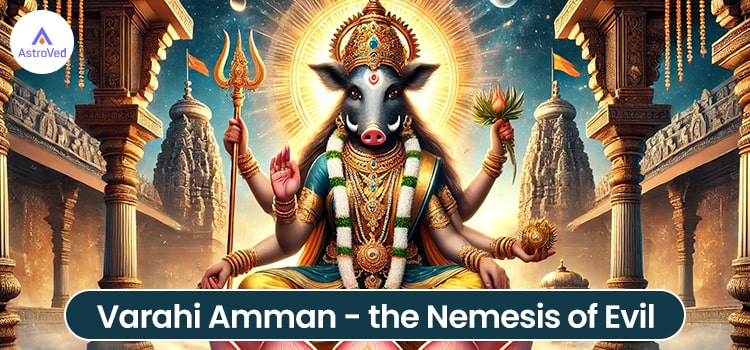Followers of each Shakta, Vaishnavite, and Shaivite cults worship varahi. Devotees are likely to worship her at evening, utilizing Vamamarga Tantrik practices that are secretive in nature. It’s from Varahi that the Buddhist goddesses Vajravarahi and Marichi originate.

Legends about Varahi
The legend of the demons, Shumbha and Nishumbha, within the Devi Mahatmya from the Markandeya Purana says that the Matrikas emerge as “Shaktis (female powers)” from the gods’ our bodies. When Shumbha challenges Goddess Durga to a battle, she absorbs all of the Matrikas into herself. The scriptures describe the Matrikas dancing on the slain demons’ blood after the battle.
The scriptures declare that Varahi emerged from Varaha. She has a boar face, wields a chakra, and does battle with a sword. Varahi is the fifth among the many Matrikas.
Based on Devi Mahatmya, within the story that describes the killing of the demon Raktabija, Durga creates the Matrikas from herself and kills the demon military with their assist.
Within the Vamana Purana, the Matrikas emerge from totally different components of Goddess Chandika, with Varahi arising from Chandika’s again.
Within the Devi Bhagavata Purana, the Earth is the receptacle of all stationary and cellular issues. After slaying the demon Hiranyaksha, Varaha rescues Prithvi (Earth) and floats her on the waters. He then has intercourse with Prithvi and impregnates her. The results of this union is Mangal, or the planet Mars. Varaha worships Prithvi as Devi Incarnate. Prithvi then says that at his command, she’s going to take the type of “Varahi” and help all the world of shifting and non-moving objects on her again.
Iconography of Varahi
Varahi has a sow’s face and a human physique. She has a black complexion that resembles the colour of a storm cloud. She holds the Earth on her tusks, like Varaha.
She wears the “Karanda Mukuta,” a crown formed like a conical basket. She has a pot stomach and massive breasts; each of those options characterize fertility.
Some consider that varahi is the yoganidra of vishnu and that she holds the universe in her womb (Bhugarbha Parameshwari Jagaddhatri).
Varahi has two, 4, six, or eight arms and is depicted sitting, standing, or dancing.
Within the “Vishnudharmottara Purana,” “Goddess Varahi” is described as 6 arms, Holding Varied Objects Like Danda (Workers to Punish) She shows abhaya and varada mudras.
In Rupamandana, Varahi Has 4 Arms, and Carries Ghanta (Bell), Chamara (A Yak's Tail), Chakra (Discus), and A Gada (MACE).
In Purva-Karanagam, She Holds Sharanga (Vishnu's Bow), The Hala (Plow), and the Musula (Pestle). The fourth hand shows the abhaya or the varada mudra.
The Agni Purana depicts her as wielding the Gada, Shankha (conch shell), sword, and Ankusha (goad).
The Devi Purana depicts her as carrying a sword, iron membership, Paasa (noose), and Khetka (defend).
Varahi’s Mounts
Varahi has many mounts. It’s often a Mahisha/buffalo. In each Vaishnava and Shakta traditions, she is portrayed as standing or sitting on a lotus pedestal or her buffalo. Typically, she sits on a boar, Sheshnag, Jambini, a horse, a lion, or on Garuda (Vishnu’s mount).
Temples for Varahi
Essentially the most well-known Varahi Amman temple in Tamil Nadu is the Sri Maha Varahi Amman Temple in Sholinghur. Sholinghur is in Vellore district, and the temple is a significant pilgrimage website for Varahi’s devotees.
